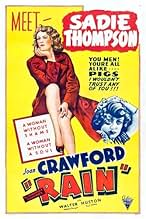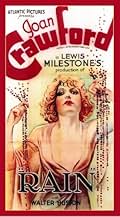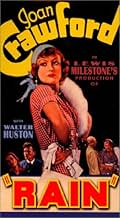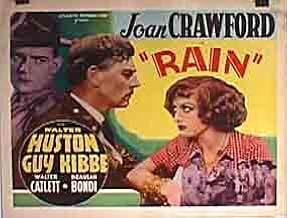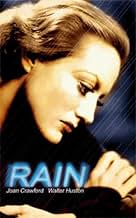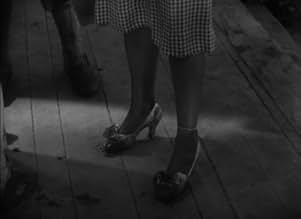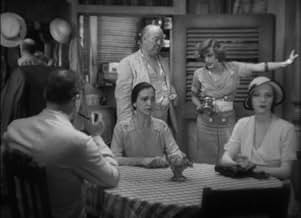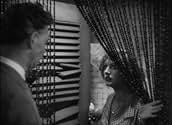AVALIAÇÃO DA IMDb
6,9/10
3,3 mil
SUA AVALIAÇÃO
Adicionar um enredo no seu idiomaA prostitute newly arrived in the South Pacific finds herself at odds with a stern missionary determined to save her soul.A prostitute newly arrived in the South Pacific finds herself at odds with a stern missionary determined to save her soul.A prostitute newly arrived in the South Pacific finds herself at odds with a stern missionary determined to save her soul.
- Direção
- Roteiristas
- Artistas
- Prêmios
- 3 vitórias no total
Fred Howard
- Hodgson
- (as Frederic Howard)
Ben Hendricks Jr.
- Griggs
- (as Ben Hendricks)
Avaliações em destaque
Try to see this on as big a viewing screen as you can, as the film is often quite dark, and Crawford is so beautiful in it you'll want a good look. I loved it!
In this second screen version of W. Somerset Maugham's morality tale, "Rain", Joan Crawford gives a performance that knocks the rest of the cast off the screen.
First made as a silent with Gloria Swanson, the stageplay "Miss Sadie Thompson" had been a controversial broadway hit, and young Joan Crawford fought hard to get the coveted role of Sadie. She shed her drawing room manners and designer gowns, researching the part by visiting the red-light district of San Diego to see what the street-walkers of the day looked and sounded like. Her appearance in the film was considered offensive for it's realism, and the film stiffed at the box office. Sadly, it's financial failure relegated Crawford to years of popular but light-weight "respectable" roles, before her Oscar-calibre performances of the 1940's and 50's.
But for audiences of today, the film is worth reconsidering. The other performers are wooden and stilted but Crawford's performance, embarrassingly natural in 1932, leaps off the screen. The topic matter that was so controversial, even offensive, in the early 1930's is not a hard sell to modern audiences: that bible-thumpers aren't always the good guys, and "sinners" aren't always so bad.
Further, the feminist aspect of the film is clearer today. As Sadie makes her way around the Pacific, a fun-loving free-spirit often one step ahead of the law, it's the fact that she's a female that draws the ire of the puritanical fire-and-brimstone missionaries: a young man would have gotten away with it.
And for us post-Woodstock viewers this touching story strikes a familiar chord: of the harmless, light-hearted kid who hurts no-one but whose very existence is offensive to the powers that be.
And it must fairly be said that when she was a young (I think she's about 25 when she made this) she is a strikingly beautiful babe, heavy make-up or not.
If you've ever written Crawford off as "man-ish" or "bitchy" because of roles she did later in her life, check out this movie and take a look at the sexy, vivacious girl who was once described by F. Scott Fitzgerald as "the personification of the American flapper"!
I found the film fascinating (that's why I went on to look up all the above information).
In this second screen version of W. Somerset Maugham's morality tale, "Rain", Joan Crawford gives a performance that knocks the rest of the cast off the screen.
First made as a silent with Gloria Swanson, the stageplay "Miss Sadie Thompson" had been a controversial broadway hit, and young Joan Crawford fought hard to get the coveted role of Sadie. She shed her drawing room manners and designer gowns, researching the part by visiting the red-light district of San Diego to see what the street-walkers of the day looked and sounded like. Her appearance in the film was considered offensive for it's realism, and the film stiffed at the box office. Sadly, it's financial failure relegated Crawford to years of popular but light-weight "respectable" roles, before her Oscar-calibre performances of the 1940's and 50's.
But for audiences of today, the film is worth reconsidering. The other performers are wooden and stilted but Crawford's performance, embarrassingly natural in 1932, leaps off the screen. The topic matter that was so controversial, even offensive, in the early 1930's is not a hard sell to modern audiences: that bible-thumpers aren't always the good guys, and "sinners" aren't always so bad.
Further, the feminist aspect of the film is clearer today. As Sadie makes her way around the Pacific, a fun-loving free-spirit often one step ahead of the law, it's the fact that she's a female that draws the ire of the puritanical fire-and-brimstone missionaries: a young man would have gotten away with it.
And for us post-Woodstock viewers this touching story strikes a familiar chord: of the harmless, light-hearted kid who hurts no-one but whose very existence is offensive to the powers that be.
And it must fairly be said that when she was a young (I think she's about 25 when she made this) she is a strikingly beautiful babe, heavy make-up or not.
If you've ever written Crawford off as "man-ish" or "bitchy" because of roles she did later in her life, check out this movie and take a look at the sexy, vivacious girl who was once described by F. Scott Fitzgerald as "the personification of the American flapper"!
I found the film fascinating (that's why I went on to look up all the above information).
This story, by Somerset Maugham, has been filmed many times in the last seventy-odd years, but this is the first. I cannot say that it is the best of all possible adaptations; a tacked-on sub-plot (involving a romance with an amorous quartermaster) helps the exposition but dilutes the icy cynicism of the basic story, the missionary and his wife are clumsy caricatures of hellfire and brimstone puritanism, while Joan Crawford's "low-class" accent is more irritating than it is believable -- one is relieved when she forgets to use it. Yet it shines.
The story is told only partially through the script, which seems less wordy than most early talkies: many important points are made purely visually, from the overflowing rainbarrel in the opening sequence to the high-heeled shoe that signals Sadie's return to her prior way of life. The camera *moves*: around tables, in and around groups of people, in and out of doors with incredible smoothness. Crawford's face is also a focus: from her initial "good-time gal" flirting with the sailors to the incredible sequence where she (apparently) converts, she leers, pouts, weeps, and more importantly, knows when to stop, in the three scenes she appears (seemingly) without makeup.
When Rev. Davidson soothes her in her extremis by telling her in a hypnotic voice (backed by native drums) that she is now "radiant, beautiful, one of the daughters of the King" (a moment of sheer unearthly poetry that verges on psychosis), we believe him -- and her. We also believe Huston's face a moment later, as he prays alone, grimaces unreadably, and suddenly resolves into a look of predatory lust just before slipping into her room, the drums implacably beating in the background.
Small excellences abound: the natives are portrayed sympathetically, and for the time, fairly accurately-- I especially liked the use of Polynesian music, which, along with the Sadie's hot jazz records, emphasises the sensual nature of life in the tropics. The subject of her profession is handled tastefully, but frankly and with humor: in referring to a friend's marriage to a sister fille de joie, the quartermaster remarks that they initally met "illegally" and goes on to say that since they met seeing each other at their worst, they can appreciate seeing each other at their best. A running counterpoint is provided by Dr. McPhail, a more-or-less neutral bystander, and Mr. Horne, the genial (and generally supinely drunk) innkeeper, who fusses, chortles, philosophizes, and gets most of the movie's best lines.
Perhaps the best of these occurs sometime after Sadie's conversion: lolling indolently, he reads from a small book something that sounds incredibly like Ecclesiates-- for a moment, we nearly believe that Davidson has converted him, too. Then, finishing the passage, he intones, "Thus spoke Zarathustra.... Good old Nietzche!"
Sixty-five years later, watching the film on a postage-stamp-sized screen of Real Video, I nearly fell out of my chair.
The story is told only partially through the script, which seems less wordy than most early talkies: many important points are made purely visually, from the overflowing rainbarrel in the opening sequence to the high-heeled shoe that signals Sadie's return to her prior way of life. The camera *moves*: around tables, in and around groups of people, in and out of doors with incredible smoothness. Crawford's face is also a focus: from her initial "good-time gal" flirting with the sailors to the incredible sequence where she (apparently) converts, she leers, pouts, weeps, and more importantly, knows when to stop, in the three scenes she appears (seemingly) without makeup.
When Rev. Davidson soothes her in her extremis by telling her in a hypnotic voice (backed by native drums) that she is now "radiant, beautiful, one of the daughters of the King" (a moment of sheer unearthly poetry that verges on psychosis), we believe him -- and her. We also believe Huston's face a moment later, as he prays alone, grimaces unreadably, and suddenly resolves into a look of predatory lust just before slipping into her room, the drums implacably beating in the background.
Small excellences abound: the natives are portrayed sympathetically, and for the time, fairly accurately-- I especially liked the use of Polynesian music, which, along with the Sadie's hot jazz records, emphasises the sensual nature of life in the tropics. The subject of her profession is handled tastefully, but frankly and with humor: in referring to a friend's marriage to a sister fille de joie, the quartermaster remarks that they initally met "illegally" and goes on to say that since they met seeing each other at their worst, they can appreciate seeing each other at their best. A running counterpoint is provided by Dr. McPhail, a more-or-less neutral bystander, and Mr. Horne, the genial (and generally supinely drunk) innkeeper, who fusses, chortles, philosophizes, and gets most of the movie's best lines.
Perhaps the best of these occurs sometime after Sadie's conversion: lolling indolently, he reads from a small book something that sounds incredibly like Ecclesiates-- for a moment, we nearly believe that Davidson has converted him, too. Then, finishing the passage, he intones, "Thus spoke Zarathustra.... Good old Nietzche!"
Sixty-five years later, watching the film on a postage-stamp-sized screen of Real Video, I nearly fell out of my chair.
Joan Crawford was reportedly not happy with her performance in Rain although for the life of me, I can't figure out what she had to be ashamed about. In a few years Rain could not possibly have been made due to the imposition of The Code where no man of the cloth could be anything less than decent.
Perhaps Crawford was unfortunately compared to Jeanne Eagels on stage and Gloria Swanson in a silent film adaptation which starred Lionel Barrymore as the sex crazed Reverend Davidson. Still Crawford's Sadie Thompson need not take a backseat to anyone else's.
Somerset Maugham wrote the original novel and John Colton adapted it into a play performed on both the London and Broadway stages. Rain is a deceptive work, at first glance it appears quite dated, but in reality its quite relevant for today.
My favorite character in this is Guy Kibbee's Horne who runs the hotel/ trading post on that tropical South Sea Island where all the characters are stranded temporarily. Joan Crawford is there and in the same hotel are the Reverend and Mrs. Davidson played by Walter Huston and Beulah Bondi. Kibbee says he left the USA because he saw that 'reformers' like the Davidsons were beginning to dominate the body politic in America and he wanted out.
Two things made Rain such a big hit at the time both as a book and play. One was Sigmund Freud who was gaining great popularity talking about repressed sexual desires. Freud would have had a field day analyzing both the Davidsons. It's important to remember that Bondi is just as repressed and uptight as Huston. Freud's writings were not just confined to his profession, they were popularly read by the masses.
The second thing was Prohibition. When Kibbee talks about the reformers triumphing (and you have to get the sneer in his voice when he says reformers)he's talking about their greatest triumph, the 18th amendment. The Evangelical Moral Majority types of the day were the ones that brought Prohibition about and America went on its biggest hypocrisy binge because of it. Folks just like the Davidsons inflicted Prohibition and all that went with it on America.
Sadie Thompson represents everything the Davidsons say they despise, but what Reverend Davidson wants. It all leads to tragedy.
What Maugham is saying and being a gay man himself, knew what it was like to be repressed and show a different face publicly, is just live and let live. Such a simple concept, but one some today have a hard time wrapping their minds around.
As for Joan Crawford, she wouldn't have said what she supposedly said about her performance in Rain knowing in the next generation there would be a musical version with a dubbed Rita Hayworth singing with the island kids. Now that one was one for the books.
Perhaps Crawford was unfortunately compared to Jeanne Eagels on stage and Gloria Swanson in a silent film adaptation which starred Lionel Barrymore as the sex crazed Reverend Davidson. Still Crawford's Sadie Thompson need not take a backseat to anyone else's.
Somerset Maugham wrote the original novel and John Colton adapted it into a play performed on both the London and Broadway stages. Rain is a deceptive work, at first glance it appears quite dated, but in reality its quite relevant for today.
My favorite character in this is Guy Kibbee's Horne who runs the hotel/ trading post on that tropical South Sea Island where all the characters are stranded temporarily. Joan Crawford is there and in the same hotel are the Reverend and Mrs. Davidson played by Walter Huston and Beulah Bondi. Kibbee says he left the USA because he saw that 'reformers' like the Davidsons were beginning to dominate the body politic in America and he wanted out.
Two things made Rain such a big hit at the time both as a book and play. One was Sigmund Freud who was gaining great popularity talking about repressed sexual desires. Freud would have had a field day analyzing both the Davidsons. It's important to remember that Bondi is just as repressed and uptight as Huston. Freud's writings were not just confined to his profession, they were popularly read by the masses.
The second thing was Prohibition. When Kibbee talks about the reformers triumphing (and you have to get the sneer in his voice when he says reformers)he's talking about their greatest triumph, the 18th amendment. The Evangelical Moral Majority types of the day were the ones that brought Prohibition about and America went on its biggest hypocrisy binge because of it. Folks just like the Davidsons inflicted Prohibition and all that went with it on America.
Sadie Thompson represents everything the Davidsons say they despise, but what Reverend Davidson wants. It all leads to tragedy.
What Maugham is saying and being a gay man himself, knew what it was like to be repressed and show a different face publicly, is just live and let live. Such a simple concept, but one some today have a hard time wrapping their minds around.
As for Joan Crawford, she wouldn't have said what she supposedly said about her performance in Rain knowing in the next generation there would be a musical version with a dubbed Rita Hayworth singing with the island kids. Now that one was one for the books.
Joan Crawford went on loan out to United Artists from her home studio of MGM to make "Rain" in 1932. The story had been a Brodway success. Some may feel Joan was miscast as the famed Sadie Thompson. I disagree. The film is not perfect, but Joan and the other actors make it worth watching. Joan is matched in the acting by the great Walter Huston, playing the preacher who is determined to "redeem" Sadie. Joan is made up heavily - almost outrageously - in the first part of the film, then softer make up and lighting after her "transformation" by the preacher. The softer make up shows what a real beauty Crawford was. Rumor has it Crawford felt out of her league with some of the other theatrically trained actors, and had some problems with the director Lewis Milestone. But she holds her own in the film. The print of the film I recorded from TCM is not the best, with some static in the sound and the picture quality rather poor. This is a film begging to be restored. Yes, it was made in 1932, but other films from this time do not look this bad.
Interesting well-directed adaptation of Somerset Maugham story about a prostitute and a missionary out to reform her. I was surprised to discover this was a box office flop when it was released as I enjoyed it very much. Joan Crawford and Walter Huston are great as the two leads. Beulah Bondi and Guy Kibbee offer solid support. But the real star is Lewis Milestone's wonderful direction. He takes what would otherwise have been a very stagey film, especially for 1932, and keeps the camera moving and lively. Milestone not only directed but produced Rain as well. He was one of the best directors of the 1930s and I don't feel like he gets anywhere near enough credit. Try to catch this if you can but beware of bad prints.
Você sabia?
- CuriosidadesCostumer Milo Anderson bought Joan Crawford's checkered dress at a department store and later recalled that the dress required extensive alteration, being far too large for Crawford everywhere except in the shoulders. Still new to the business, Anderson did not realize that multiple copies would be needed of a costume worn so extensively throughout the film. When it came time for a second copy, Anderson discovered that the dress had sold out and was now not available anywhere. Nor could the checkered fabric be located. Since the dress had already been seen in numerous scenes, the only solution was to have the design laboriously painted onto cloth and then have the dress duplicated. The dress had originally been store-bought to save money--and ultimately, with all the work, it added considerably to the film's budget.
- Erros de gravaçãoAt the beginning, where the ship's passengers are handing over their passports and shore passes to be checked, the serial number on all the passes is the same.
- Citações
Sadie Thompson: You men! PIGS!
- ConexõesEdited into Haunted Hollywood: Rain (2016)
- Trilhas sonorasSt. Louis Blues
(1914) (uncredited)
Written by W.C. Handy
Played during the opening credits and often in the score
Principais escolhas
Faça login para avaliar e ver a lista de recomendações personalizadas
- How long is Rain?Fornecido pela Alexa
Detalhes
- Data de lançamento
- País de origem
- Idioma
- Também conhecido como
- Amor profano
- Locações de filme
- Empresa de produção
- Consulte mais créditos da empresa na IMDbPro
Bilheteria
- Faturamento bruto nos EUA e Canadá
- US$ 1.172.840
- Faturamento bruto mundial
- US$ 1.534.720
- Tempo de duração1 hora 34 minutos
- Cor
- Proporção
- 1.37 : 1
Contribua para esta página
Sugerir uma alteração ou adicionar conteúdo ausente


